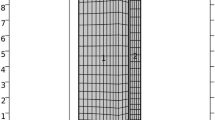Abstract
Light water reactor fuel is a multicomponent system required to produce thermal energy through the fission process, efficiently transfer the thermal energy to the coolant system, and provide a barrier to fission product release by maintaining structural integrity. The operating conditions within a reactor induce complex multi-physics phenomena that occur over time scales ranging from less than a microsecond to years and act over distances ranging from inter-atomic spacing to meters. These conditions impose challenging and unique modeling, simulation, and verification data requirements in order to accurately determine the state of the fuel during its lifetime in the reactor. The capabilities and limitations of the current engineering-scale one-dimensional and two-dimensional fuel performance codes is discussed and the challenges of employing higher level fidelity atomistic modeling techniques such as molecular dynamics and phase-field simulations is presented.
Similar content being viewed by others
References
J.S. Armijo, L.F. Coffin, and H.S. Rosenbaum, Zirconium in the Nuclear Industry; Tenth International Symposium, ASTM STP 1245, ed. A.M. Garde and E.R. Bradley (Philadelphia, PA: American Society for Testing and Materials, 1994), pp. 3–18.
J.P. Mardon, D. Charquet, and J. Senevat, Zirconium in the Nuclear Industry: Twelfth International Symposium, ASTM STP 1354, ed. G.P. Sabol and G.D. Moany (West Conshohocken, PA: American Society for Testing and Materials, 2000), pp. 505–524.
G.P. Sabol, R.J. Comstock, R.A. Weiner, P. Larouere, and R.N. Stanutz, Zirconium in the Nuclear Industry; Tenth International Symposium, ASTM STP 1245, ed. A.M. Garde and E.R. Bradley (Philadelphia, PA: American Society for Testing and Materials, 1994), pp. 724–744.
“Falcon Fuel Performance Code Version 1,” Product ID: 1020707 (Palo Alto, CA: EPRI, 2010).
“Fuel Reliability Guidelines—Pellet-Cladding Interaction,” Product ID 1015453 (Palo Alto, CA: EPRI, November 2008).
G.A. Berna, C.E. Beyer, K.L. Davis, and D.D. Lanning, “FRAPCON-3: A Computer Code for the Calculation of Steady-State, Thermal-Mechanical Behavior of Oxide Fuel Rods for High Burnup,” NUREG/CR-6534, Vol. 2, PNNL-11513 (Richland, WA: Pacific Northwest National Laboratory, December 1997).
M.E. Cunningham, C.E. Beyer, and P.G. Medvedev, “FRAPTRAN: A Computer Code for the Transient Analysis of Oxide Fuel Rods,” NUREG/CR-6739, Vol. 1, PNNL-13576 (Richland, WA: Pacific Northwest National Laboratory, 2001).
J. Brochard, F. Bentejac, and N. Hourdequin, “Nonlinear Finite Element Studies of the Pellet-cladding Mechanical Interaction in a PWR Fuel” (Paper presented at CW/4, Transactions of the 14th International Conference on Structural Mechanics in Reactor Technology (SMiRT 14), Lyon, France, August 17–22, 1997).
K. Lassmann, Nuclear Engineering and Design, 57 (1980), pp. 17–39.
D.T. Hagrman, “MATPRO—A Library of Materials Properties for Light Water Reactor Accident Analysis,” SCDAP/RELAP5/MOD3.1 Code Manual, Vol. 4, NUREG/CR-6150, EGG-2720 (Washington, D.C.: Nuclear Regulatory Commission, June 1995).
W. Lyon, R. Montgomery, J. Rashid, and S. Yagnik, “PCI Analysis and Fuel Rod Failure Prediction using FALCON” (Paper presented at the 2009 Water Reactor Fuel Performance Meeting, Paris, France, September 6–10, 2009).
“CASL—Consortium for Advanced Simulation of Light Water Reactors,” a DOE Energy Innovation Hub (May 28, 2010, formally opened May 3, 2011), www.casl.gov.
S.K. Yagnik, D.S. Sunderland, and B. Cheng, “Effect of PWR Restart Ramp Rate on Pellet-Cladding Interactions” (Paper presented at the International Seminar on Pellet-Clad Interactions with Water Reactor Fuels, Aix-en-Provence, France, March 2004).
R. Yang et al., “An Integrated Approach to Maximizing Fuel Reliability” (Paper presented at the 2004 International Meeting of LWR Fuel Performance, Orlando, Florida, September 2004).
M. Stan, Nuclear Engineering and Technology, 41(1) (February 2009), pp. 39–52.
M. Tonks et al., Nuclear Engineering and Design, 240(10) (2010), pp. 2877–2883.
D. Vega et al. “Toward an Atomistically Informed Fuel Performance Code: Thermal Properties Using FRAPCON and Molecular Dynamics,” Nuclear Technology, 165 (March 2009), pp. 308–312.
T. Watanabe et al., J. Nuc. Mater., 375 (2008), pp. 388–396.
B. Wirth et al., “Multiscale Investigation of the Mechanisms Controlling Irradiation Effects in Materials” (Presentation at the OSU-INL Multiphysics Methods Workshop, Sunriver, Oregon, June 8–9, 2010).
A. Palagin, “Analysis of Thermal Conductivity of Irradiated UO2 Fuel,” Transactions, SMiRT 19 August 2007), paper C04/2.
Author information
Authors and Affiliations
Corresponding author
Rights and permissions
About this article
Cite this article
Rashid, J.Y.R., Yagnik, S.K. & Montgomery, R.O. Light water reactor fuel performance modeling and multi-dimensional simulation. JOM 63, 81–88 (2011). https://doi.org/10.1007/s11837-011-0144-9
Published:
Issue Date:
DOI: https://doi.org/10.1007/s11837-011-0144-9




